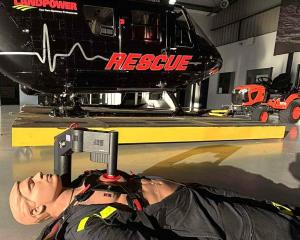Dog-handler Matt Gunn said "without the likes of him and others, we could not do what we do".
"I might have to name my next dog after him."
Mr Gunn said the dog team at Treble Cone was not the only one in the area.
Dogs were also trained at Coronet Peak and Cardrona specifically for avalanche rescue.
During the ski season, Aspiring Avalanche Dogs aimed to have its dogs do two mock rescues a week, which involved a human volunteer hiding in a snow cave waiting for the dogs to track their scent.
"The dogs are working to find the reward.
"In most cases, it's a toy," Mr Gunn said.
"They just follow that scent to the source. Ideally, you want them to dig and bark."
Volunteers in the snow caves were equipped with a radio transceiver, a breathing tube and an emergency blanket.
In a real avalanche situation, once the handlers had determined whether an area was safe enough to operate a ground search, the dogs were deployed downwind of the area to better ensure they would pick up a scent.
"What happens is the dog will walk across the site and, when they pick up the scent, their body language changes.
"Sometimes it will be quite subtle and sometimes quite dramatic."
If a dog did pick up a scent and start digging, handlers would use probes to determine whether someone was buried under snow and, if so, they would put their avalanche shovels to work.
A strong "play drive and a strong prey drive" were essential for potential avalanche dogs and the organisation had adopted the police testing scale for pups, Mr Gunn said.
"We try and do it [choose pups] through LandSAR channels, [to get] the offspring of proven dogs."
In the 12 years Aspiring Avalanche Dogs has been operating it has attended nine searches.
Within that number, it was deployed by the New Zealand Police for three search-and-rescue operations.












